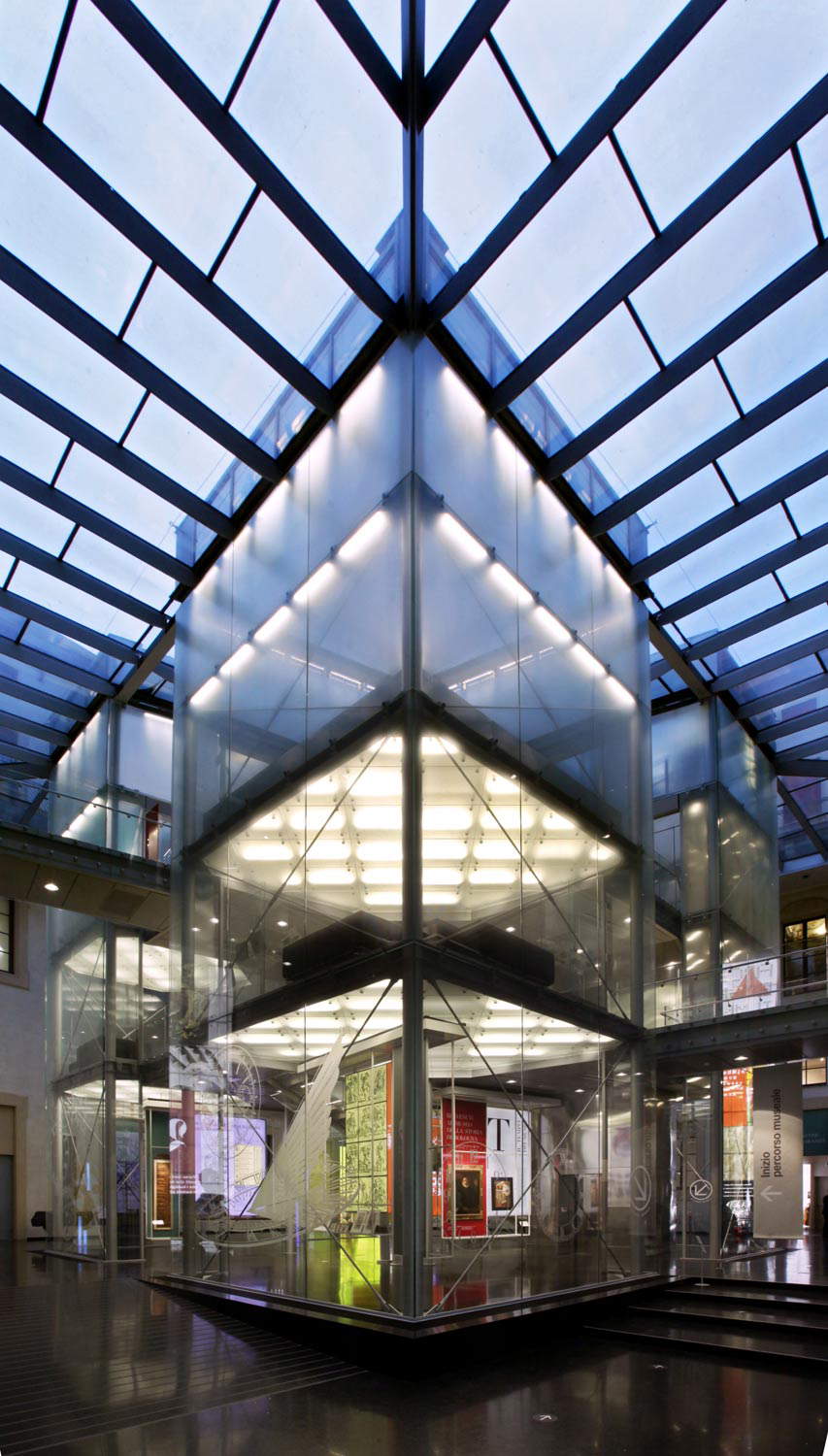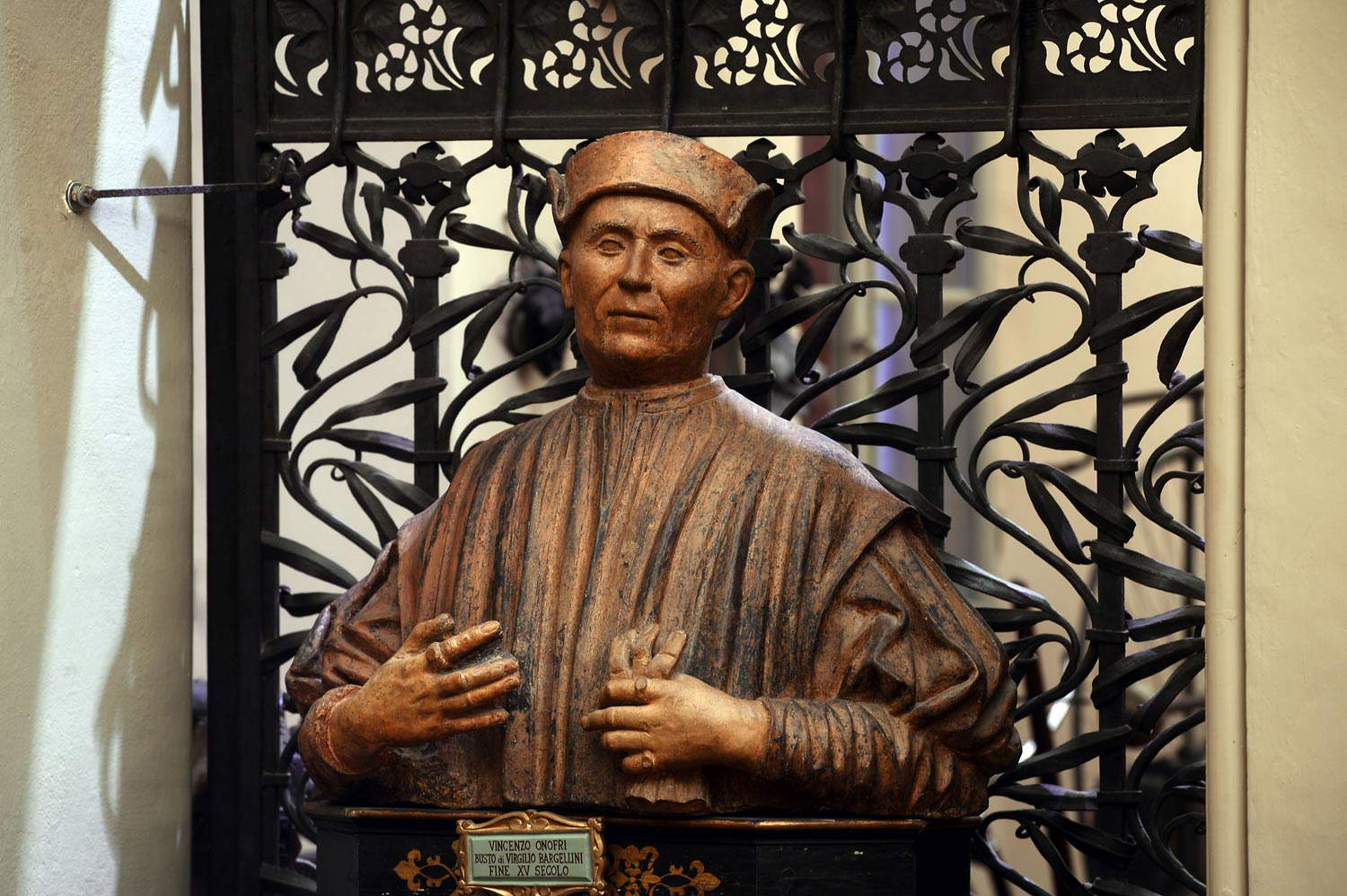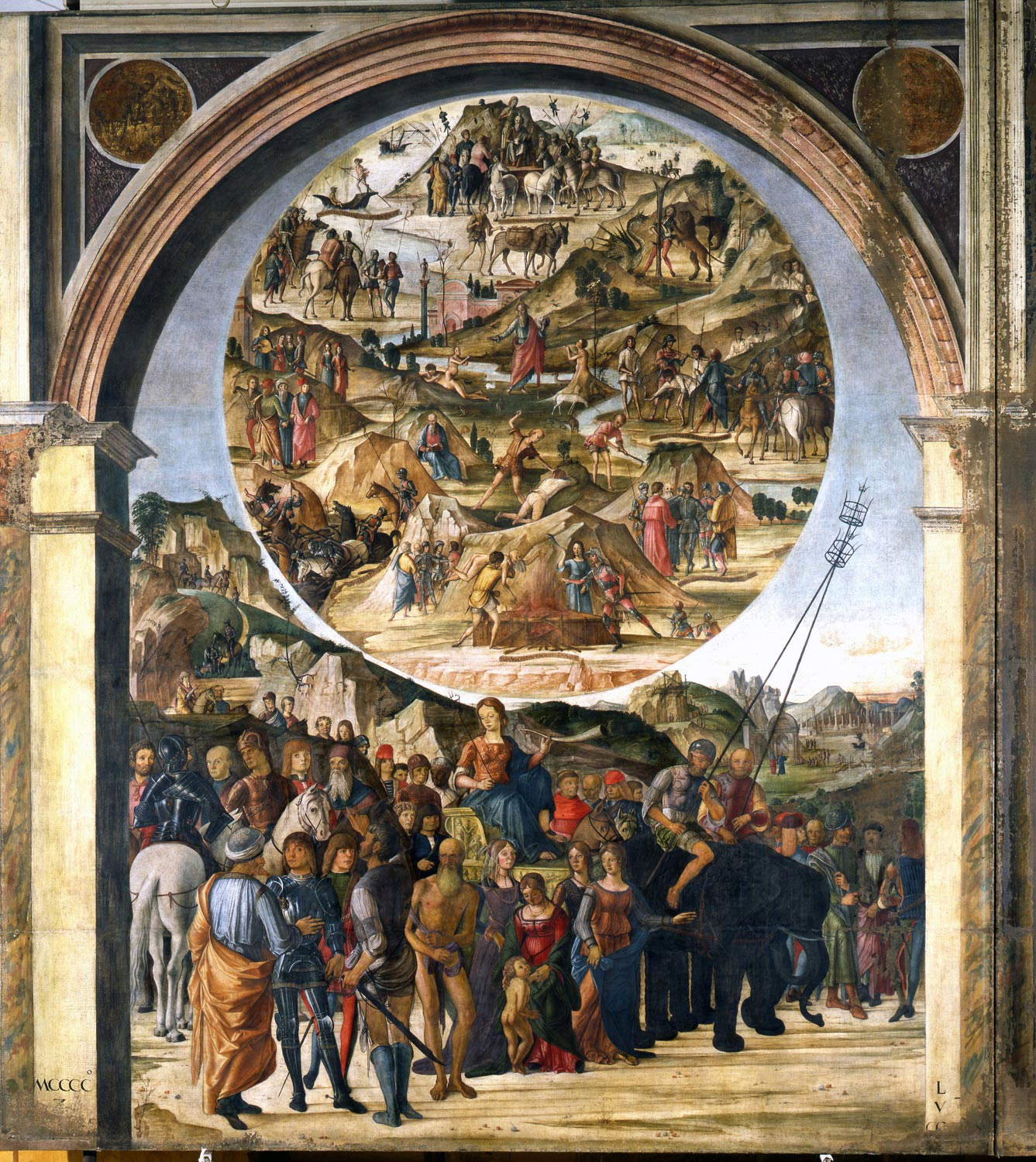Bologna is known in the world’s imagination above all for the medieval splendor still visible in the features of the historic urban fabric, testifying to its rise as one of the most important cosmopolitan centers in Europe between the 13th and 14th centuries. However, Bologna also knows moments of glory during the magnificent season of the Renaissance. In its peculiar “rustic and proud” declension, the Renaissance in Bologna constitutes one of the leading events in Italian artistic history. Although uninterruptedly intertwined with the previous tradition of forms and materials, from the second half of the fifteenth century the city participated in the humanistic innovations in a lively climate of renewal that fostered an extraordinary impulse for the transformation of its architectural and infrastructural configuration, and the development of a multifaceted artistic culture capable of dialoguing not only with the ancient, but also with other centers such as Florence, Milan and Rome.
Although it is not always possible to specify the ways and times of the construction sites in which they intervened, it is known that all the great protagonists and theorists of the period (from Leon Battista Alberti to Donatello, from Michelangelo Buonarroti to Bramante, from Leonardo da Vinci to Raphael Sanzio) stayed or otherwise worked for the city, contributing to changing its artistic culture with new languages and expressive sensibilities. Although the complex political vicissitudes that pitted the Bentivoglio seigniory and the papal power of Julius II against each other in the 15th century caused the loss of magnificent monuments and numerous works of art, there are still numerous masterpieces preserved in almost all the churches and museums in the historic center that visitors can admire.
On the occasion of the exhibition Julius II and Raphael. A New Season of the Renaissance in Bologna (at the Pinacoteca Nazionale di Bologna from Oct. 8, 2022 to Feb. 5, 2023), three of the city’s museum institutions (Musei Civici d’Arte Antica | Settore Musei Civici Bologna, Genus Bononiae - Musei nella Città and SMA - Sistema Museale di Ateneo | Università of Bologna) have launched a dedicated cultural and tourism promotion campaign through Bologna’s Renaissance places, with the collaboration of Territorio Turistico Bologna - Modena, Bologna Chamber of Commerce Industria Artigianato e Agricoltura, Azienda di Promozione Turistica della Regione Emilia-Romagna and Bologna Welcome. An itinerary in nine emblematic places where key works by the main artists who made the Felsine figurative civilization between the 15th and 16th centuries grandiose can be seen: Niccolò dell’Arca (Bari, c. 1435 - Bologna, 1494), Francesco Raibolini known as il Francia (Bologna, c. 1460 - 1517), Amico Aspertini (Bologna, 1474 or 1475 - 1552), as well as the Ferrara-based Francesco Del Cossa (Ferrara, 1436 - Bologna, 1478), Ercole de’ Roberti (Ferrara, 1451-1456 - Ferrara, 1496) and Lorenzo Costa (Ferrara, 1460 - Mantua, 1535).
“The Renaissance itinerary,” explains Elena Di Gioia, the mayor’s delegate for Culture of Bologna and the Metropolitan City, “starts from the Pinacoteca and develops through nine stages that show the richness of the memories of the Renaissance kept in the permanent museum collections and churches or represented by the palaces that are home to the museums. It is a project of great quality that will surely arouse the curiosity of residents and numerous tourists toward discovering the historical identity of our city.” Here are the places to visit:
The Renaissance sections of the Pinacoteca Nazionale di Bologna include works by some of the greatest masters active in Emilia between the 15th and 16th centuries, starting with Raphael’s celebrated Ecstasy of St. Cecilia from the church of San Giovanni in Monte, the same house of worship in which Pietro Perugino’s Madonna in Glory and Saints was once kept. Among the masterpieces are the Felicini Altarpiece, the Manzuoli Altarpiece, the Scappi Altarpiece and the Bentivoglio Altarpiece by Francesco Francia, theAdoration of the Magi by Amico Aspertini, the Marriage of the Virgin by Lorenzo Costa, the Saint Michael and the Face of Magdalene by Ercole de’ Roberti, the Merchants’ Altarpiece by Francesco del Cossa, Cima da Conegliano’s Madonna and Child , until we get to Titian Vecellio ’s Jesus and the Good Thief and Tintoretto’s Visitation . Parmigianino is present with the famous Madonna of Saint Margaret.

The Municipal Art Collections are housed in Palazzo d’Accursio on Piazza Maggiore. Part of the building’s Renaissance structures, such as the great Court of Honor, the Scalone or the Clock Tower, are still admired by the public today. Works of great importance are preserved in the collections, such as Francesco Francia’s Crucifixion with Saints John and Jerome or Amico Aspertini’s Virgin Suckling.

The museum is housed in one of Bologna’s best-preserved Renaissance palaces and has a unique collection. The Bentivoglio era is represented by rare artifacts such as the Stocco, a sword donated by Pope Nicholas V to Ludovico Bentivoglio, or the Targone, a parade shield painted with St. George and the Dragon, or the tomb of Domenico Garganelli, a polymathic work among Francesco del Cossa’s masterpieces.

Palazzo Pepoli Vecchio, home to one of the most powerful families in medieval-era Bologna, is now a museum that tells the story of this city. In the excursus of centuries that is unfolded in the halls of the Palace, a large space is devoted to the Bologna of the Renaissance. In this complex century, the Bentivoglio family emerges, whose apotheosis of power will be portrayed by some of the greatest artists of the period such as Lorenzo Costa. The Museum of History is an essential stop to reconstruct the historical context of the Renaissance epic in the city of Bologna.

The Davia Bargellini Museum is housed in the charming palace of the same name; it preserves the memory of the powerful allied Bentivoglio family, in particular Gaspare and Virgilio were co-leaders of the Bolognese epic. Among the many Renaissance works are: the bust of Virgil by Vincenzo Onofri, his alleged portrait attributed to Aspertini, and Raphaelesque-style paintings of St. Lawrence and St. Petronius by Innocenzo da Imola, formerly in Santa Maria dei Servi.

The Church of San Giacomo Maggiore houses the Bentivoglio family chapel, an authentic masterpiece of the Bolognese Renaissance. The chapel was decorated by the two main artists active in Bologna at the end of the 15th century: Lorenzo Costa and Francesco Francia. The latter are again authors, together with Amico Aspertini, of the decoration, started in 1506, for one of the most important pictorial cycles of the Bolognese Renaissance preserved in the Oratory of Santa Cecilia.

From the Renaissance of courts and great artists to the “other Renaissance,” that of early scientists, collectors and observers of nature. In the rooms of Palazzo Poggi, decorated by frescoes from the Mannerist season, the University of Bologna preserves an exceptional treasure: that of Ulisse Aldrovandi (1522-1605), professor and inventor of the modern science museum. Aldrovandi’s museum, donated to the City of Bologna, is not dispersed but has come down to us almost intact. Also worth seeing are the decorations by Niccolò dell’Abate.

The Scream of Stone - with these words D’Annunzio defined the sculptural complex of the Lamentation over the Dead Christ by Niccolò dell’Arca, dating from around 1463. The work is set inside the church of Santa Maria della Vita, which dates back to 1200, the year in which the company of the same name was founded to care for the sick, prisoners and those condemned to death. Inside this important place of worship, in the chapel to the right of the main altar, you can admire one of the sculptural masterpieces that after six hundred years still arouses pathos and admiration.

During the Renaissance, the majestic basilica, a symbol of the devotion of the Bolognese, was the focus of important artistic campaigns. There are numerous testimonies, such as the decoration of the side windows, where Niccolò dell’Arca and Francesco di Simone Ferrucci also worked, or the current layout of the facade. The interior holds masterpieces by all the protagonists of the season: from Costa active in the De’ Rossi Chapel, to Onofri in the Lamentation, to various paintings by Aspertini.

To support the resources made available by each of the institutional realities involved in the cultural synergy project and in order to optimize its attractive potential for citizens and tourists, Bologna Welcome, a company that deals with the development and management of tourist reception activities as well as of the promotion of Bologna and its territory both nationally and internationally, has designed and implemented a series of integrated communication actions focused on the recognition of Bologna as one of the main Italian artistic capitals during the 15th and 16th centuries, as the distinctive theme of the exhibition offer for autumn-winter 2022/23.
The system of supports and services designed to engage and accompany different target audiences includes:
the web minisite (www.bolognawelcome.com/it/informazioni/rinascimento-a-bologna) in Italian and English. The project’s main online resource, the minisite introduces visitors to individual places of interest and acts as an access point to a series of other online resources: audioguide-podcasts, booking and ticket purchase systems, original editorial content, Promenade a Bologna brochure in its digital version; the brochure Il Rinascimento a Bologna in Italian and English. The project’s main offline resource, it presents the public with an introduction to the theme of the Renaissance in Bologna and describes the main places of interest, referring to the online content for further details. It will be distributed in the city’s main tourist promotion points as well as in the venues involved in the Renaissance trail; theaudio guide-podcast in Italian language at the following link: www.bolognawelcome.com/it/informazioni/rinascimento-a-bologna. The narrative on the Renaissance in Bologna takes on a voice thanks to audio tracks featuring Roberto Balzani (president SMA - Sistema Museale di Ateneo | University of Bologna), Paolo Cova (art historian, Musei Civici d’Arte Antica | Settore Musei Civici Bologna), Angelo Mazza (conservator Art and History Collections of Fondazione Cassa di Risparmio in Bologna) and Maria Luisa Pacelli (director Pinacoteca Nazionale di Bologna). These audio resources offer an ideal complement to the foldout, illustrating places and specifics of the itinerary and enriching them with details about the protagonists of the time, artists and figures in the city’s political life, as well as the salient events of that season. Listening is recommended both during the visit and at an earlier or later time, to prepare in advance and complete the experience; Promenade in Bologna, the traditional guidebook created by Bologna Welcome’s editorial staff in Italian and English will be available from November 2022 and for the occasion will offer thematic itineraries and new content useful for narrating and increasing knowledge about the artistic events of the Renaissance in Bologna.
The initiatives and media created for the public will also be promoted through dedicated digital advertising activities and thanks to a radio campaign on Radio 3 Rai (commercials will air for four weeks, between October and November).
In addition, at the headquarters of the Pinacoteca Nazionale di Bologna, Bologna Welcome staff will manage the bookshop related to the exhibition Giulio II and Raffaello. A New Season of the Renaissance in Bologna and a reception and tourist information point. For those who wish to be accompanied by an expert guide, a guided tour service is available. Reservations should be made by emailing booking@bolognawelcome.it.
The website bolognawelcome.com provides useful information for visiting the places of Renaissance Bologna, as well as curiosities, information and anecdotes about the history of the masterpieces preserved in the city.
 |
| Bologna in the Renaissance, what to see: a 9-step itinerary |
Warning: the translation into English of the original Italian article was created using automatic tools. We undertake to review all articles, but we do not guarantee the total absence of inaccuracies in the translation due to the program. You can find the original by clicking on the ITA button. If you find any mistake,please contact us.